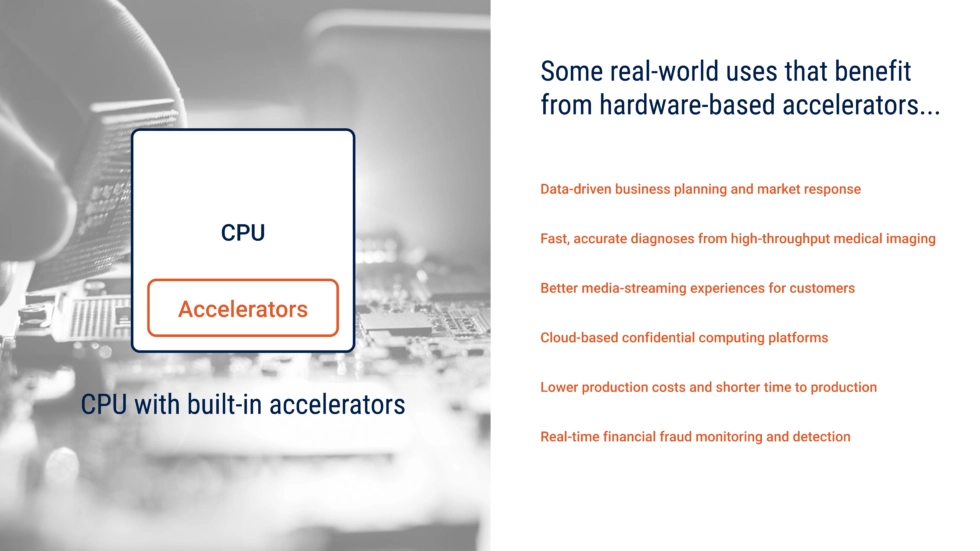What Is a Hardware-Based Accelerator?
In basic terms, a hardware-based accelerator is purpose-built circuitry used to enhance the performance of certain functions or workloads. Hardware-based accelerators can be divided into two categories: a discrete processor card such as a graphics processing unit (GPU), or silicon on chip (SoC) circuitry built into a CPU.
While an accelerator and a general-purpose processor may target similar operations, the accelerator will perform better (higher throughput, lower latency) and more efficiently (require fewer hardware and power resources). Hardware-based accelerators have existed as a niche market for some time. In recent years, however, artificial intelligence (AI), big data analytics, high-performance computing (HPC), internet of things (IoT) sensors, distributed databases, public clouds, and other advanced computing platforms have pushed general-purpose chips to their processing limits. This need for greater computing power is driving the evolution of new, purpose-built processor technologies.
Today’s accelerator market is flush with hardware-based accelerators built for a wide variety of workloads, which run in public, private, and hybrid clouds, on-premises servers, hyperscale data centers, mobile devices, and at the network edge. And the demand for hardware-based accelerators shows no signs of slowing down. Market Research Future predicts the hardware acceleration market will grow by a whopping 51 percent over the next eight years, reaching 75.2 billion US dollars (USD) in sales by the year 2030.1
In this article, we will be discussing the benefits of using CPUs with built-in accelerators.
Why You Should Be Using Built-In Accelerators
In short, built-in accelerators process data or complete tasks faster than general purpose devices, benefitting you by reducing time to solution, power consumption, and hardware and operating costs.
The slightly longer explanation is that modern workloads are sensitive to application latency and performance throttling, so they can benefit significantly from hardware-based acceleration. Here are a few examples of real-world benefits you can get from highly optimized workloads.
- Faster data analysis enables businesses to better adapt to rapidly changing market conditions.
- Accelerated simulations and business information modeling (BIM) help engineers and manufacturers reduce production costs and time to production.
- A faster machine learning (ML) pipeline can help financial institutions deploy real-time fraud monitoring and detection.
- Physicians can use high-throughput medical imaging to diagnose diseases quickly and accurately, meaning their patients can start treatment sooner.
- Smoother, faster media streaming increases customer satisfaction and retention for content delivery network (CDN) providers.
- Security acceleration can help healthcare organizations use a cloud-based confidential computing platform for patient records.

Figure 1. Use CPUs with built-in accelerators and be rewarded with real-world benefits
Choosing the Right Built-In Accelerator
We recommend keeping things simple—choose an accelerator based on your business goals. For example, are you looking to make the most of your existing infrastructure? If you are running workloads on Intel® Xeon® Scalable processors, we have good news. You can deploy some or all of the following built-in accelerators without having to purchase additional hardware:
- Intel® AI Engines are purpose-built to boost inference and training performance.
- Intel® HPC Engines enhance performance for the most demanding, compute-intensive workloads.
- Intel® Security Engines protect platforms, systems, and data without impacting performance.
- Intel® Network Engines accelerate load-balancing, compression, and vRAN for high-density computing platforms.
- Intel® Analytics help database and data-intensive workloads run faster and more efficiently.
- Intel® Storage speeds data movement and reduces latency for data storage platforms.
Getting Started on Your Hardware-Based Accelerator Journey
To Learn More
Read more about hardware acceleration in the following Prowess reports and articles:
To learn more about what we do at Prowess Consulting, view our latest research and follow us on LinkedIn.
1 Calculated as compound annual growth rate (CAGR) of 51 percent. “Hardware Acceleration Market Research Report – Global Forecast till 2030.” Market Research Future. September 2022. www.marketresearchfuture.com/reports/hardware-acceleration-market-8249.
Related Posts

SharePoint vs. OneDrive: Which One Is Right for Your Business?
Comparing Microsoft® SharePoint® to Microsoft® OneDrive® isn’t entirely straightforward, because it is not an apples-to-apples comparison. You might need both, or you might need neither.

Cloud Evolution: Trends Shaping the Future of Public Cloud Services
In the rapidly advancing landscape of information technology (IT), the evolution of public cloud services is a pivotal force. With data centers worldwide, public cloud

Navigating Hybrid Data with Microsoft® Azure® Arc for Seamless Management
Organizations like yours face an intricate challenge when managing a blend of on-premises, cloud, and edge resources. IT resources sprawled between your on-premises IT estate



